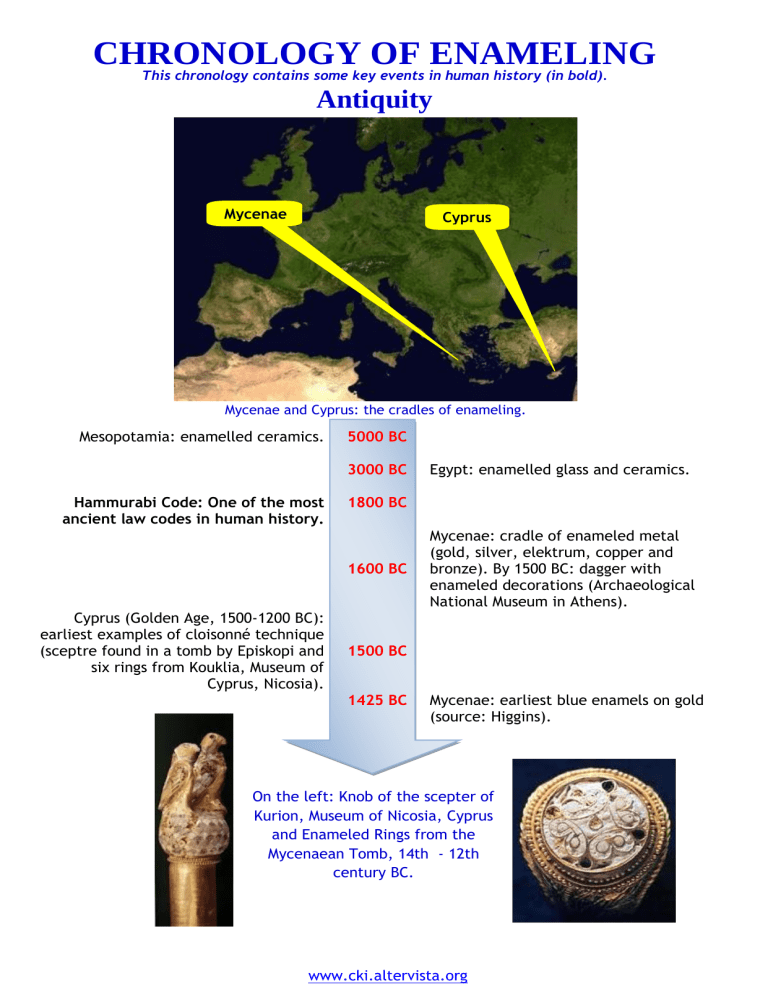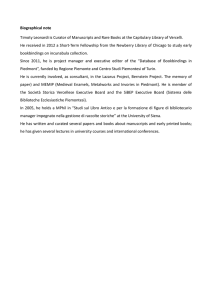chronology of enameling - CKI

CHRONOLOGY OF ENAMELING
This chronology contains some key events in human history (in bold).
Antiquity
Mycenae
Cyprus
Mycenae and Cyprus: the cradles of enameling.
Mesopotamia: enamelled ceramics.
Hammurabi Code: One of the most
3000 BC ancient law codes in human history.
5000 BC
1800 BC
Egypt: enamelled glass and ceramics.
1600 BC
Mycenae: cradle of enameled metal
(gold, silver, elektrum, copper and bronze). By 1500 BC: dagger with enameled decorations (Archaeological
National Museum in Athens).
Cyprus (Golden Age, 1500-1200 BC): earliest examples of cloisonné technique
(sceptre found in a tomb by Episkopi and six rings from Kouklia, Museum of
1500 BC
Cyprus, Nicosia).
1425 BC Mycenae: earliest blue enamels on gold
(source: Higgins).
On the left: Knob of the scepter of
Kurion, Museum of Nicosia, Cyprus and Enameled Rings from the
Mycenaean Tomb, 14th - 12th century BC. www.cki.altervista.org
Azerbaijan: filigree enamel (rosette in a tiara, treasure of Ziwiye).
800 BC
753 BC Traditional and legendary date of the foundation of Rome.
Europe: introduction of lead enamelling
(Nomadic Barbarians, 700-200 CBC) 700 BC
Etruria, Tuscany, south Italy: traces of
600 BC Celtic Gaul: monochrome red enamel. champlevé enamel. The Celts practice champlevé enamel (La Tène period).
Banks of the Rhine: first German enamel
(69-96 AD).
Production of the iron crown, which will be completed in many phases by 800 AD and will be worn by many emperors.
400 BC
6 BC
69 AD
100 AD
400 AD
476 AD
Birth of Jesus Christ.
Beginning of the Christian Era.
North Europe: Britons and Celts practice enamelling (100-300 BC).
Deposition of Romulus Augustulus.
End of the Western Roman Empire.
Beginning of the Middle Ages.
Examples of British enamels found in England and dated to the period
1 st -2 nd century AD.
The iron cron, produced in the
Langobard period and modified on many stages between 400 and 800
AD. www.cki.altervista.org
Middle Ages
Byzantine art: cloisonné and mixed technique (500-1204).
500
646 Japan (Nara Age, 646-794): first traces of Shippo Yaki (cloisonné enamelling).
Treatise of Eraclius: De coloribus et artibus romanorum .
700
775
Charlemagne receives the iron crown, which is now complete after four centuries of additions.
Carlo Magno imperatore del Sacro
Romano Impero.
800
840
Golden altar in the Church of St.
Ambrose (Milan) produced with enamels by goldsmith Volvinio.
Milan, Treves, Limoges: gilded copper replaces gold as bases for champlevé enamelling.
900
1000
Spreading of champlevé and cloisonné techniques in Europe (boxes,
First Crusade. 1099 reliquaries, religious plaques).
Above: enamelled gold cover from a
Gospel book, Byzantine art. On the right: formella from the altar in the
Church of St. Ambrose in Milan (with detail above). www.cki.altervista.org
Enamel Schools: Meuse (Liegi and
Verdun), Rhine (Cologne) and early
Limoges (central France).
Theophilus: Diversarum artium schedula : manuscript with information on cloisonné enamel.
Expansion of the Pala d’Oro in the basilica of St Mark, Venice.
China, Yuan Dynasty (1271-1368): first
Oriental cloisonné enamels.
Ad facendum emallum : Latin treatise containing the earliest known recipe specifically for enamel.
1100
1102
Ordelaf Falier, Doge of Venice (1102-
1118) commissions the Pala d’Oro in St.
Mark, produced by goldsmiths from
Constantinople and completed by 1105.
1123
Limoges (1150-1250): ateliers flourish
1150
1204
(notable amount of enamelled liturgical objects in champlevé technique).
1220
1271
1290
1300
Shrine of the Three Kings, produce dover 30 years by goldsmith Nicolas de
Verdun (Rhine School).
Earliest basse-taille enamel: Chalice of
Pope Nicholas IV by Guccio di Mannaia, goldsmith from Siena.
1337
1368
Reliquary of the Bolsena corporal
(Ugolino di Vieri, Orvieto Cathedral): translucent basse-taille enamel on silver.
China, Ming Dynasty (1368-1644): golden age for early Chinese cloisonné.
On the right: detail of prophet Amos on the Reliquary of the Magi. Below: a champlevé crosier and a bassetaille reliquary (12 th century). www.cki.altervista.org
Japan: enamel decoration of monuments and buildings.
Limoges, in the workshop now known at
Pseudo-Monvaerni: diffusion of the
émail-peint technique. Venice: production of copper artifacts ornamented with enamel and glided patterning (pitchers, cups and dishes).
1436
1445
Jean Fouquet returns from Italy and applies the knowledge acquired from
Filarete in the creation of his famous self-portrait: earliest example of émailpeint known to date, now in the Louvre
Museum, Paris.
1450
On the left: self-portrait by Jean Fouquet, first example of émail peint (1445).
On the right: portrait of the Palatine Count Jean Philippe (Léonard Limosin, 1550).
Modernity
Christopher Columbus discovers
America. End of the Middle Ages, beginning of modernity.
1492
1500
1530
Limoges, Nardon Pénicaud’s atelier: a new, complex narrative technique of enamel painting on copper ( émail de peintres ).
First appearance of the grisaille technique.
1536 Léonard Limosin begins his activity, becoming the most famous of enamel
(Limoges School). www.cki.altervista.org
Posthumous publication of Leonardo ’s
Treatise on Painting, compiled as a collection of manuscripts, where the famous painter and scientist from
Tuscany praises enamel for combining the properties of painting (which he considers the most noble art) with the virtually eternal durability of this
1542 material.
1543 Benvenuto Cellini : Salt-cellar for
Francis I, king of France (ronde-bosse
Trattati dell’oreficeria e della scultura
(Benvenuto Cellini).
Blois (France), atelier of Jean Toutin : earliest enamel miniatures, later followed especially in Paris and Geneva.
1568 enamel on gold).
1620
1632
1650
Japan: Hirata School, famous for producing enamelled silver sword guards).
Activity of Jean I Petitot
Jean Toutin in France.
, Swiss enameler who learned miniature art by
On the left: Salt-Cellar of Francis I (Benvenuto Cellini, ronde-bosse, 1543).
On the right: The Folly (Jean I Laudin, grisaille technique, half of the 17 th century). www.cki.altervista.org
Example of enamel miniature, produced by Jean I
Petitot (1607-1691).
Miniature spreads in France. 1700
1750
Battersea (England): first factory for the production of enamelled objects ornamented with transfer printing techniques.
TECHNICAL ENAMELLING STARTS.
See. Chronology of Technical Enamel The archbishop of Rostov opens in his palace the first enamelling atelier, dedicated to icon miniatures. This is the birth of the finift technique (Russian enamel miniature).
England, Henry Bone (1755-1834):
1789 Beginning of the French Revolution. recreation with enamels of small copies of the works of the Old Masters (Rubens,
Raphale, Titian...), following the tastes of his time.
Invention of the daguerreotype: rapid decay of enamel portraits.
Explosion of mass production.
Publication of manual L’émail des peintres of Claudius Popelin.
1760
1800
1823
1839
1850
1866
In Japan, Kaji Tsunekichi is officially recognized as cloisonné producer.
1861
Manufacture Nationale des Porcelaines de Sèvres : revival of Limoges painting in the Renaissance manner.
The law n.4671 of the Kingdom of
Sardinia proclaims the birth of the
Kingdom of Italy. www.cki.altervista.org
Two Fabergé Eggs, created by the “jeweler of the tsars”, Carl Fabergé and by his atelier.
Carl Fabergé (St. Petersburg 1846 –
Losanna 1920) produces the first
“Febergé Egg” as an Easter present for the queen by her husband tsar
Alexander III of Russia. The production of the tenth splendid works in guilloché was worthy of the title jeweler of the tsars .
1885
1896
Influence of the new artistic movements (Art Déco – Art Nouveau) on enamel.
International Expo in Paris. French
Goldsmith and enameller René Jules
Lalique participates, becoming a wellfamed jeweler, sculptor and glassmaker
1900 at a worldwide level.
1914 World War I (1914-1918).
Howard Carter discovers Tutankhamen’s 1922 tomb. (1341-1323).
1931 Death of Giuseppe Guidi , personal enameller of Gabriele d’Annunzio, aged
50.
1934
U.S.A., Edward Winter (active 1934-
1970): beginning of artistic enamelling of large scale plates.
At the end of World War II, the
1939 World War II (1939-1945). monastery of Ligugé opens a new lab of artistic enamelling. This atelier’s work will inspire the foundars of Studio Del
Campo.
1945 www.cki.altervista.org
Pax-Table, the first onehanded work by German artist Egino Weinert (1946).
U.S.A. and England: development of artistic enamelling, publication of manuals with different techniques for art schools. Meanwhile, German artist
Egino Weinert founds his first atelier, beginning his career that will see him produce important works for all Pontiffs in the 20 th century.
1951
1952
The “Istituto d’Arte Ferruccio
Mengaroni” , presided by Ferruccio
Ferri and teacher Vladimiro Vannini, becomes the source of new talent in enamel art, such as Bucci, Bastianelòli,
Jacomucci, Baldassarri and Sparaventi, who also became teachers on their own. Cinciarini and Verzolini will also be great artisans-artists. In Kouklia
(Cipro) , finding of the first cloisonné enamels (1500 BC).
Giuseppe Calonaci founds S.I.V.A.
, a factory of artistic enamels on steel, where many artists have been invited to work (Silvano Bozzolini, Pierachille
Cuniberti, Gualtiero Nativi, Marta
Pieraccini Bozzolini, Concetto Pozzati).
1955
1956
Virgilio Bari, Lidia Lanfranconi, Bianca
Tuninetto ed Euclide Chiambretti found their first atelier independent of the
“Comunità Artistica”: Studio Del
Campo is founded in Turin.
Germany, Gertrud Rittmann-Fischer : atelier Gabriele becomes Creativ-Kreis-
International, a non-profit association with artistic-humanitarian which collects and educates artists from around the world.
1966
Logos of C.K.I. International (left) and
Italian (right). www.cki.altervista.org
Jean Zamora, disciple of great artist
Jean Betourné, wins the title of best artisan-artist of France.
1976
1981
Enameller Mario Maré (1921-1993) educates his manual “Lo Smalto a Fuoco
1995 sui Metalli”.
First exposition of C.K.I. in Italy in Nova
Milanese.
Opening of Old Mill Museum (Alte
1996 Paolo de Poli dies, aged 91.
Mühle) by the Abbey of Himmerod
(Germany), cultural and artistic see of
C.K.I. International.
Second exposition of C.K.I. in Italy (Nova
Milanese).
1997
1999
2005
2011
Miranda Rognoni is president of C.K.I.
Italy. She will have this charge until her death 10 years later in perfect harmony with founder Gertrud Rittmann-Fischer.
Third exposition of C.K.I. in Italy (Nova
Milanese). Attilio Compagnoni
President of C.K.I. Italy.
Two stations from the Way of the Cross in the Church of St.
Nicholas in Padua
(De Poli, 1968).
www.cki.altervista.org
